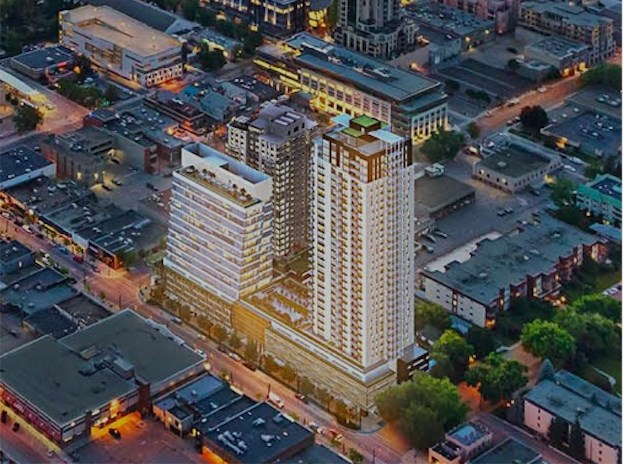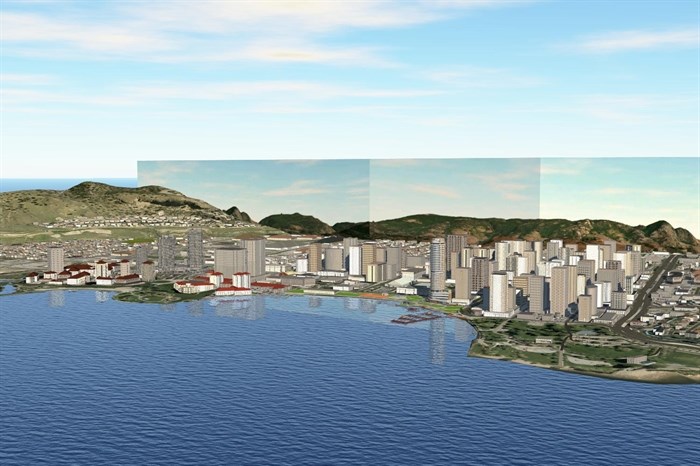
One tower of the Bernard Block is under construction with work on two more towers expected to start soon. A 46-storey high-rise is planned right next to them.
Image Credit: liveatbrooklyn.com
February 07, 2021 - 6:30 AM
Much of downtown Kelowna, where dozens of highrises have either been built or are in the works, was once swampy land prone to flooding.
The alluvial till is so unstable, it's why the William R Bennett bridge has to float. Yet the latest proposal is for a 46-storey tower to be built next to three shorter towers near Bernard Avenue at Bertram Street downtown.
And One Water Street – at 36 storeys, the tallest highrise actually under construction – is only a block or so from Okanagan Lake.
So, how is it possible to build so many towers in such poor soil and why isn’t the city forcing them to go further inland to places like the Landmark Centre?
“The alluvial fan that makes up the flatter area of downtown Kelowna is a combination of all kinds of different kinds of soil stratums,” Terry Kowal, the City of Kelowna’s building inspections supervisor, told iNFOnews.ca. “We’ve got a lot of buildings that would be on lighter soil conditions than, say, some cities that are building on granite or rock.”
READ MORE: Why the Okanagan Lake bridge has to float
A case in point is downtown Vancouver that has a lot of bedrock. But other Lower Mainland cities, such as Coquitlam and Pitt Meadows, have towers in poorer soil, explained Omar AlHarra, a project engineer with Glotman-Simpson Consulting Engineers, the structural engineer of record for the Mission Group on its Bernard Block and Brooklyn tower project.
The Bernard Block is the three tower complex – 16, 26 and 34 storeys – on Bernard Avenue between Bertram and St. Paul streets. That’s right beside the proposed site of that proposed 46-storey tower called 2020.
READ MORE: This corner of downtown Kelowna is about to change drastically
In fact, Kowal said, much of the lower levels of Kelowna are on that same alluvial fan. Soils are “bonier” – meaning they have more rock in them – closer to Mission Creek but don’t really get solid until the top of the Rutland Bench.
But elevation is not a guarantee of solid ground. There are six to nine metres of sand in areas of Westpoint in the Upper Mission which was the shore of Okanagan Lake centuries ago.
The key to keeping buildings from sinking into the ground or tipping over is good engineering, Kowal explained.
“There are some very complex calculations that the engineers do for a bunch of different loads, or combined load cases,” he said.
Those include snow loads, calculating for winds and adjusting for different building loads in different areas of the foundation.
“That’s part of what the engineers do to make sure the buildings remain vertical and upright and stable and don’t sway too much or don’t slowly start to roll over like the Leaning Tower of Pisa,” Kowal said. “They do all that stuff to ensure the end result is a safe, stable structure.”
AlHarras and fellow engineer Anthony El-Araj explained that they also design buildings in Kelowna to withstand a one in 25,000 year earthquake.
Highrises have been around for hundreds of years and Kowal doesn’t know of any that have failed structurally in North America.
What makes these buildings stable is the fact that, in Kelowna, they can sit on pilings that are about half the height of the buildings themselves.
People who have been around for years may recall huge piles of gravel piled on empty lots to compact the soils.
Much of that dirt started off compacting soil at the Conservatory in Glenmore, moving downtown to a number of sites, including One Water Street, before returning to Glenmore. That’s a good demonstration of the fact that soils far away from Okanagan Lake still need compacting.
It’s a useful technique if the developer has a couple of years to let it do its work but it also has a sponge effect so, when the soil is removed, construction has to be done fairly quickly before the soil springs back.
In some cases, a floating concrete pad is suitable but that only works for lower, squarer buildings, like the TD bank building in downtown Kelowna, Kowal said.

This rendering of Kelowna's downtown skyline in 20 year's time was published in 2018.
Image Credit: SUBMITTED/ Aplin & Martin/Josh Graff
When it comes to the highrises, it’s the steel pilings that do the trick.
They are hauled in 12-metre lengths over the Coquihalla Highway then vibrated into the soil, with new sections welded on as they go down, some as deep as 60 metres.
That can be a third of a building’s total height. One Water Street, at 36 storeys, has 118.55 metres above ground and 60 metres underground. If the 2020 gets built at 46 storeys it will be 137 metres tall.
Had One Water Street been a taller and, therefore, heavier building, the pilings would likely have gone deeper, Kowal said.
The dirt pile did sit on the One Water Street site at one time but that was not enough to compact the soil for such tall buildings (the second tower is 29 storeys).
The idea is to vibrate the pilings into the soil until they compact the soil enough to hold the weight of the building.
“So, in a way, you’re bypassing all the upper soil layers that are not very great until you get to a deep enough point in the ground, with better soil conditions, and you’ve transferred the load from the highrise above to the lower soil layer,” AlHarras explained.
At the Bernard Block, two buildings will be on one foundation that will contain about 200 pilings, AlHarras said. Some will go down about 50 metres but others will not need to be driven so deep. It depends on what part of the building they’re holding up and the soil conditions at that spot.
Despite the multitude of highrises going into that area of the city, there is really no limit to how many or how or how tall they can be built.
“Engineering-wise, we have great confidence in the performance of these deep foundation systems,” AlHarras said. “Obviously, it takes a lot more engineering effort during the design stage of these projects and a lot more studies and coordination with the geotechnical engineers but it’s certainly doable.”
And it isn’t up to Kowal or his inspectors alone to ensure that all this work is done right.
The calculations these engineers do are all peer reviewed to make sure they are correct and cities hire consulting engineers to check the work as it progresses. As well, people like AlHarras do site inspections to make sure their directions are being followed.
Does that mean they’re infallible?
Not necessarily.
Some Kelowna residents will remember the saga of the Discovery Bay Resort when it had structural problems.
A B.C. Supreme Court ruling said the city revoked it’s occupancy permit on Oct. 19, 2005 and didn’t reinstate it until Dec. 6, 2007.
That, Kowal said, was not the fault of the foundations. It was a miscalculation by an engineer on some of the structural supports of the ground-level parkade that had to be repaired.
It was also in a wood framed section of the complex that is not a high rise, which is generally something more than six storeys high.
There are now at least nine towers built or under construction in downtown Kelowna that are more than 10 storeys high with at least a dozen more planned.
READ MORE: iN PHOTOS: The high-rise future of Kelowna's skyline
To contact a reporter for this story, email Rob Munro or call 250-808-0143 or email the editor. You can also submit photos, videos or news tips to the newsroom and be entered to win a monthly prize draw.
We welcome your comments and opinions on our stories but play nice. We won't censor or delete comments unless they contain off-topic statements or links, unnecessary vulgarity, false facts, spam or obviously fake profiles. If you have any concerns about what you see in comments, email the editor in the link above.
News from © iNFOnews, 2021